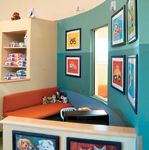Brick by brick
Use these guidelines to balance appearance, cost, and durability when you choose interior building materials.
Selecting materials and finishes is a balancing act. You're weighing color and appearance against the cost to install the material, the cost to maintain it, and its estimated life span. When focusing on appearance, consider the range of available colors, textures, patterns, and sizes. When considering cost, identify the initial cost of the product, installation, maintenance over time, and the cost of replacing the product at the end of its life cycle.

Finally, think about what kind of performance you need from the product and decide what surface finish will work best. You should always find out how long the product typically lasts, install it according to the directions, and consider the surface. Ideally, go look at the product at use in another animal hospital. It's great to see how it holds up under the conditions you'll experience.
With these basic strategies in mind, I'm going to discuss some specific materials for floors, walls, and ceilings. But this list clearly doesn't include every product available or address every situation. These are simply finish options that I've seen work well in the various facilities I've designed over the years.
Flooring
- Vinyl composition tile. This is a basic, inexpensive, and durable material, but not the easiest to use because it has so many joints. Typically, it comes in 12-inch square tiles, and you can find many colors and patterns. You'll need to wax frequently to prevent surface wear and to keep joints sealed, because they can't be heat or chemically welded. Generally, you use a rubber base with this product, and it costs $1.75 to $2.50 per square foot.
- Sheet vinyl is also durable and easy-to-maintain. Seams can be heat or chemically welded, and the base can be coved for a seamless joint. Select only commercial-grade, homogeneous PVC, which means that the color and pattern extend completely through the product. Most manufacturers recommend waxing to prevent surface wearing and to help keep joints sealed. You can use a rubber base with this product. Sheet vinyl costs $3.50 to $5.50 per square foot.
- Porcelain tile. Practices often pick this beautiful material for public areas of the hospital, but it can be used throughout the practice. Select tile that doesn't require sealing with a light traction surface, and use epoxy grout in medium to dark colors. A rubber base can also be used. Porcelain tile costs $5 to $11.50 per square foot.
- Liquid-applied epoxy with ceramic granules is durable and easy to clean, although fairly expensive. Surface preparation is critical, and you really need experienced, factory-certified installers. I suggest a surface with light traction. Liquid-applied epoxy comes in many colors and can be applied to walls, too. But be aware that this isn't epoxy paint or coating. Epoxy paint or coating peels off of floors, but it can be used on concrete block walls. Installed, liquid-applied epoxy costs $6.50 to $8.75 per square foot.
- Exposed concrete slab. Many veterinarians choose this durable, affordable material for runs and utility areas. Concrete is porous so it must be sealed. I recommend you use a hardener/sealer combination that bonds with the surface of the slab to protect the floor. And keep in mind, you must reapply these sealers over time. You can also color concrete floors or stain the surface.
Use a hardener/sealer combination to protect the floor. Figure 50 cents a square foot for sealer, an additional $1.75 per square foot for integrally colored concrete, and $2.50 more per square foot for surface-stained concrete.
Walls
- Painted gypsum board or painted concrete blocks let you use washable eggshell latex enamel in areas that need gentle cleaning. Use eggshell alkyd (oil-based) enamel in areas where you need a higher-durability finish. In the surgery and other areas that require frequent scrubbing, use two-part, high-solid epoxy, not latex. Both the gypsum board and concrete block can be painted.
I don't recommend vinyl wallpaper, because it's expensive and not very durable. Holes and scratches appear easily and aren't simple to repair.
Ceilings
- Acoustical ceiling tile absorbs sound. In fact, it's one of the few spots in an animal hospital that can. A lay-in acoustical ceiling system works best. Your building team will mount the sound-absorbing ceiling tiles in a suspended metal grid. The relatively high moisture level in animal facilities means you'll need two-foot square tiles in order to resist sagging.
You want the materials you choose to look great on opening day. But you also want them to look terrific in a year. And it would be even better if they looked great in 10 years. So juggle the variables, and opt for the best you can afford. Keep in mind, a bigger up-front investment generally translates into less maintenance and more time before you need to start replacing materials.
Veterinary Economics Editorial Advisory Board member Daniel D. Chapel, AIA, owns Chapel Associates Architects Inc. in Little Rock, Ark. He has designed veterinary facilities for 28 years and has completed more than 400 successful hospitals and kennels. Chapel will speak on selecting a site and making it work; landscaping, parking, entries, and curb appeal; and appealing exam rooms that work at the 2006 Veterinary Economics Hospital Design Conference, Aug. 23 to 25 in Kansas City, Mo. He'll also moderate a panel discussion about what materials work best. Send questions or comments to ve@advanstar.com

Daniel D. Chapel, AIA
design
Critical color decisions
Make an impression. Set a mood. Tap clients' emotions. Smart color choices let you do all this and more.
By Wendy Wheeler
The real challenge in setting a color scheme: maintaining a level of control. Your final design should be cohesive and balanced. Too much color can be overbearing; too little can be unnoticeable. Here are some ideas to get you started on the color selection process:
- Pull from the outside. Consider incorporating the same color family and building materials on the interior as on the exterior. For instance, if you install a deep green metal roof, consider repeating this as a muted, pale shade of green on the interior.

Bright accent colors punch up this children's alcove at Pet Medical Center of San Antonio, designed by BDA Architecture.
- Go for the wow factor. If you're leasing space or in a building that desperately needs a facelift, you may not have the option of reflecting the exterior inside your building. Tenant improvements allow you to punch it up and make that first impression with your clients. For example, incorporate a bold or bright accent color on the wall behind the reception desk and to accentuate the retail area, adoption alcove, or children's play corner. Keep remaining areas neutral to obtain balance within the design.
- Coordinate with the logo. Company logos make a great starting point for color schemes. One client I worked with requested teal, which was in the practice's logo. I was a bit leery at first; teal reminded me too much of the popular '80s show Miami Vice—not the inspiration I had hoped for. Yet the end result still wows people today. The vibrant teal was used in moderation as an accent color throughout the facility. Soft butter yellows and warm grays help tone down the intensity of the teal and provide a neutral background.
Consider permanent finishes
Popular colors change. To avoid a costly remodel within five years, consider choosing neutral and earth-tone colors for permanent materials, such as tile, concrete, resilient flooring, built-in wood accents, and possibly cabinetry. Save bold and trendy colors for finishes such as paint, wallcoverings, countertops, carpet, and fabrics.
Use neutrals—whites, creams, tans, and grays—to balance accent colors. Use earth tones—rusts, greens, golds, browns, and deep grays—to complement accent colors. Earth tones are my color preference for flooring because, unlike neutrals, they tend to be darker and less likely to show foot-traffic patterns between cleanings.
Communication through color
Color creates a mood and communicates emotion. You can foster different feelings using different colors. For example:
- Red expresses heat and intensity. It can increase the heart rate and raise blood pressure.
- Orange conveys excitement and cheerfulness.
- Yellow is stimulating and promotes activity. Prolonged exposure can cause anxiety.
- Green signifies harmony and has associations with health and well-being.
- Blue encourages thought and contemplation. It can lower body temperature and blood pressure; yet it can be depressing if overused.
- Violet carries the contrast of red and blue and therefore may cause associations with tension and ambiguity. Some may consider pale shades of violet to be sensitive and artistic.
Visual effects
A single room has the ability to reflect different spatial impressions with different colors and values. Warm colors—red, orange, and yellow—advance and appear to draw surfaces closer. Cool colors—green, blue, and violet—recede and appear to make a room larger. Dark colors absorb light and therefore create the appearance of an intimate space. Here are some ways to apply these concepts in your practice:
- A light-colored floor will make your exam room appear larger.
- A bright, white ceiling will visually raise the height of your waiting room.
- A dark ceiling above the reception desk will visually lower the height above your checkout alcove.
- A long, narrow hall will seem more in proportion if you paint its far walls a darker color than the long, side walls.
- Bright, warm colors in boarding suites that offer no natural light will bring warmth and energy to the space.
- Cool colors in an overheated, south-facing doctor's office will appear to cool the room's temperature.
Wendy Wheeler is director of design at BDA Architecture, P.C., in Albuquerque, N.M. She will speak on setting the tone in the reception area and on lighting and color for effect and efficiency at the Veterinary Economics Hospital Design Conference, Aug. 23 to 25 in Kansas City, Mo.

Wendy Wheeler